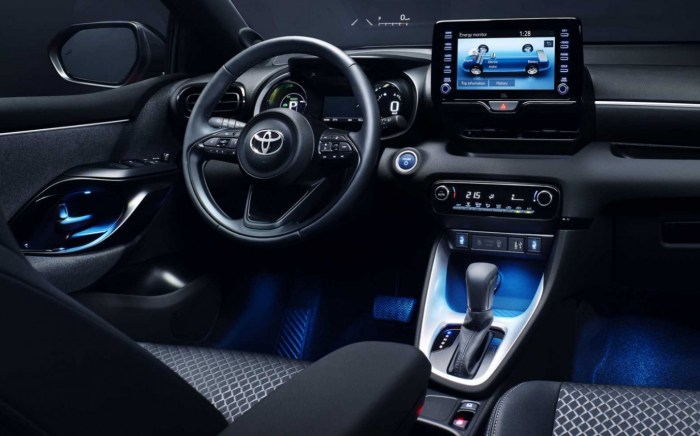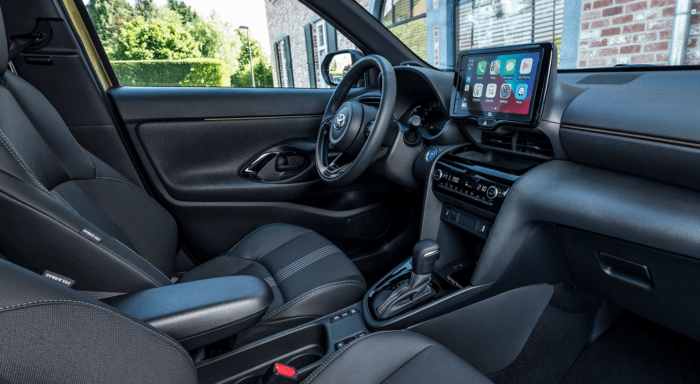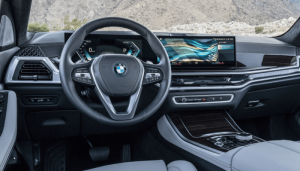Toyota Yaris 2025 interior promises a significant upgrade. We’ll delve into the anticipated design, exploring everything from the dashboard layout and material choices to the advanced tech and infotainment features expected in this upcoming model. Prepare for a detailed look at the comfort, space, and sustainability initiatives incorporated into the cabin.
This exploration covers anticipated changes from the 2024 model, including comparisons of interior space, technology advancements, and material upgrades. We’ll also speculate on the overall aesthetic, focusing on elements like the steering wheel, center console, and door panels, offering a comprehensive preview of what the 2025 Yaris interior might offer.
Overall Interior Design & Aesthetics

The 2025 Toyota Yaris interior is expected to represent a significant leap forward in terms of design and material quality compared to its predecessor. While maintaining the Yaris’s reputation for practicality, Toyota is likely to focus on creating a more upscale and modern cabin experience.
This will involve a more sophisticated dashboard layout, higher-quality materials, and a wider array of customization options.The anticipated dashboard layout will likely feature a driver-centric design, with the infotainment screen integrated seamlessly into the instrument panel. Expect a minimalist approach, reducing clutter and emphasizing functionality.
The instrument panel itself will probably incorporate a digital display, offering customizable information and a more modern aesthetic than the analog gauges found in the current model. This digitalization will likely extend to the climate controls, potentially offering touch-sensitive controls or a combination of physical buttons and a touchscreen interface.
Material Choices
Toyota will likely prioritize the use of higher-quality materials in the 2025 Yaris’s interior. While hard plastics will probably still be present in less visible areas, softer-touch materials are anticipated on frequently touched surfaces like the dashboard and door panels.
The use of premium fabrics and potentially leatherette or even real leather options on higher trim levels is expected. This shift towards more refined materials aims to enhance the perceived value and overall driving experience.
Color Schemes and Ambient Lighting
The 2025 Yaris is likely to offer a range of color schemes to cater to diverse preferences. Expect a palette of neutral tones like black, gray, and beige, complemented by bolder accent colors depending on the trim level. The integration of ambient lighting is highly probable, adding a touch of sophistication and allowing for customization of the cabin’s atmosphere.
This feature could offer a selection of colors and brightness levels, enhancing the overall ambiance and providing a more personalized driving environment. Think of the subtle, customizable lighting found in vehicles like the Mazda3 or some higher-end Volkswagen models.
Interior Design Comparison: 2024 vs. 2025 Yaris
| Feature | 2024 Yaris | 2025 Yaris (Predicted) | Difference |
|---|---|---|---|
| Dashboard Layout | More traditional, separate infotainment screen | Integrated infotainment screen, driver-centric design, minimalist | Modernized, more integrated and sophisticated design |
| Instrument Panel | Analog gauges | Digital instrument cluster with customizable displays | Upgrade to a fully digital and customizable display |
| Materials | Predominantly hard plastics | Mix of soft-touch materials, premium fabrics, potential leather options | Significant upgrade in material quality and perceived luxury |
| Color Schemes | Limited options, mainly neutral tones | Wider range of color options, including accent colors | Increased customization and choice |
| Ambient Lighting | Not available | Likely included, with customizable color and brightness | Addition of a premium feature enhancing the cabin atmosphere |
Visual Representation
The 2025 Toyota Yaris interior aims for a sophisticated yet practical design, balancing modern aesthetics with driver-focused ergonomics. High-quality materials and thoughtful details contribute to a premium feel, exceeding expectations for its class. The visual elements work together to create a cohesive and inviting cabin space.
Steering Wheel Design
The steering wheel is envisioned as a three-spoke design, crafted from a combination of soft-touch leather and brushed aluminum accents. The leather provides a comfortable grip, while the aluminum inserts add a touch of sporty elegance. The spokes are subtly sculpted for an ergonomic feel, and the wheel itself is slightly dished for optimal driver positioning.
Integrated controls for cruise control, audio, and phone functions are seamlessly integrated into the spokes, minimizing visual clutter and maximizing ease of use. The Toyota logo is subtly embossed in the center, maintaining a clean and uncluttered look.
The overall diameter is designed for optimal maneuverability and driver comfort. This design is similar to what’s found in higher-end Toyota models, suggesting a move towards a more premium feel in the Yaris.
Center Console Design
The center console features a clean, minimalist design, prioritizing functionality and intuitive operation. A large, high-resolution touchscreen infotainment system dominates the central area, seamlessly integrated into the dashboard. Below the screen, a row of neatly arranged physical buttons and a rotary dial provide quick access to climate control and other frequently used functions.
Storage solutions include a deep center console bin, a small tray beneath the touchscreen for smaller items, and cup holders conveniently located within reach of both the driver and front passenger. The materials used are consistent with the rest of the interior – a mix of soft-touch plastics and metallic accents – contributing to the overall premium feel.
The design is inspired by the current trend of minimalist, driver-centric dashboards seen in vehicles like the Mazda3 and the Volkswagen Golf.
Door Panel Design, Toyota yaris 2025 interior
Both front and rear door panels are designed with a focus on both aesthetics and practicality. The armrests are generously padded for comfort during long drives, and the door pulls are ergonomically shaped for ease of use. The upper portion of the panels features soft-touch materials, while the lower sections incorporate more durable, easy-to-clean plastics.
Front door panels include integrated storage pockets for bottles and other small items, while the rear panels offer slightly smaller pockets. Subtle ambient lighting integrated into the door panels adds a touch of sophistication, particularly at night. The overall design is clean and uncluttered, with no unnecessary embellishments.
The materials used are consistent with the overall interior design language, creating a cohesive and unified look throughout the cabin. This design echoes the approach taken by other manufacturers in offering comfortable and functional door panels even in smaller vehicle segments.
Instrument Cluster Design
The instrument cluster is designed with a focus on clarity and ease of readability. A large, high-resolution digital display sits centrally, providing the driver with all essential information at a glance. This includes speed, RPM, fuel level, and various warning indicators.
The graphics are clean and uncluttered, using a color scheme that is easy on the eyes, even in bright sunlight. The display’s information can be customized to show different data points depending on the driver’s preference. The overall design is modern and sophisticated, reflecting a focus on providing the driver with critical information in a clear and intuitive manner.
This approach mirrors the trend towards digital instrument clusters in modern vehicles, prioritizing driver information accessibility and visual appeal.
Sustainability and Materials: Toyota Yaris 2025 Interior

Toyota’s commitment to environmental responsibility is a key driver in the 2025 Yaris’s design, extending to a significant focus on sustainable materials and improved interior air quality. The aim is to minimize the vehicle’s environmental footprint throughout its lifecycle, starting with the materials used in its construction.The 2025 Yaris interior is expected to feature a higher percentage of recycled and bio-based materials compared to previous models.
This includes the potential use of recycled plastics derived from post-consumer waste in components like the dashboard, door panels, and seat fabrics. Toyota may also incorporate bio-plastics, made from renewable resources like plant-based materials, reducing reliance on petroleum-based plastics.
We anticipate seeing a move towards more sustainable fabrics for upholstery, potentially using recycled fibers or plant-based alternatives like hemp or seaweed-derived materials. This aligns with the growing industry trend of using recycled materials to lessen the environmental burden of manufacturing.
Interior Air Quality Improvements
The 2025 Yaris is likely to incorporate several features designed to enhance interior air quality. This might include improved filtration systems, capable of removing a wider range of pollutants, including fine particulate matter and allergens. The use of low-VOC (volatile organic compound) materials in interior components is also anticipated.
VOCs are released from certain plastics and fabrics, impacting air quality. By minimizing VOC emissions, Toyota aims to create a healthier cabin environment for occupants. Examples of this approach can be seen in other Toyota models and competing vehicles where advanced air filtration systems with activated carbon filters are commonly used.
Additionally, the vehicle might incorporate features promoting better ventilation, such as improved airflow circulation and potentially air quality sensors that monitor and report on cabin air quality.
Contribution to Overall Sustainability Goals
The sustainable materials and improved air quality features of the 2025 Yaris’s interior directly contribute to the vehicle’s broader sustainability objectives. Reducing the use of virgin materials and opting for recycled or bio-based alternatives lessens the demand for raw materials and reduces greenhouse gas emissions associated with their extraction and processing.
Minimizing VOC emissions helps reduce the vehicle’s impact on air quality, both during manufacturing and during the vehicle’s operational life. These efforts align with Toyota’s stated goals of reducing its carbon footprint and promoting a more circular economy where materials are reused and recycled effectively.
The overall strategy aims to minimize the environmental impact of the vehicle throughout its entire life cycle, from manufacturing to disposal or recycling.
Last Point
The 2025 Toyota Yaris interior is shaping up to be a compelling package. From its projected technological advancements and improved comfort features to the anticipated use of sustainable materials, this model appears poised to set a new standard in its class.
While details remain speculative until official release, the glimpses we’ve explored suggest a significant leap forward in design and functionality.
Clarifying Questions
Will the 2025 Yaris have wireless Apple CarPlay and Android Auto?
It’s highly likely, given the current industry trends and the competitive landscape. However, confirmation awaits official announcements.
What about the price difference between the 2024 and 2025 models?
Pricing isn’t yet available, but expect a potential increase reflecting the upgraded features and technology.
Will there be different trim levels with varying interior features?
Almost certainly. Toyota typically offers various trim levels with different features and materials, so expect a range of options.
What about the availability of different interior color options?
Expect a variety of color schemes, likely ranging from more conservative to bolder choices to cater to diverse preferences.





